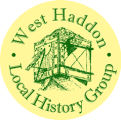Schooling In West Haddon
In The Begining
With the advance of the Industrial Revolution, the need for a more educated and skilled population grew, resulting in a greater need for schools countrywide. Kelly’s Directory of 1864 refers to the Heygate School in West Haddon as forming part of the National Schools Network.
Three Sunday schools also played an important part in the education of West Haddon children.
West Haddon Public Elementary School for children aged 3 to 14 years, was built in 1825 endowed by John Heygate Esq. with a house and garden for the Master and Mistress, two adjoining cottages and the sum of £1,000, vested in Trustees. The rent from the cottages went to school funds.
The original Trust Deed for the school is dated September 2nd 1825.
| The 21 Trustees were: | |
| John Heygate | Thomas Lovell |
| Thomas Heygate | William Lovell |
| William Butin | Isaac Lovell |
| Robert Heygate | Robert Kilsby |
| John Heygate | William Kilsby |
| Charles Heygate | John Gulliver |
| Thos. Heygate Junior | Thomas Underwood |
| Wm. Heygate Junior | George Jackson |
| William Lovett | Nathaniel Parnell |
| Thos. Walter Slye | John Manton |
| John Smith | |
It was a charity school for educating and instructing the poor children of West Haddon and Winwick, between the ages of five and twelve. The boys were to learn reading, writing, casting accounts and English grammar. The girls were also to learn Knitting and plain needlework.
Mr Heygate hoped that the school would run in accordance with Anglican ideals, but soon this view came under attack. In 1863 the County Court in Daventry was asked to settle the matter. The conclusion was that ‘In future the school should be conducted on the principles of the Established Church but that parents were able to exempt their children from being instructed in the doctrines of the Church of England providing that they declare their conscientious objections in writing and attend another place of worship (at least once) on Sundays.
The connection with the Church is still strong, with the Vicar being Chairman of the Governors, and the children having to attend Church at least three times a year.
When the school was first endowed there were no fees, but soon a fee of 1d per month was requested to cover the cost of books, slates, pens, ink etc. for each child. In 1874, payment to Parish children by a Board of Guardians commenced, this was received quarterly. In February 1882 a note in the school log reports that the Trustees discussed the question of raising the fees of the scholars. It was decided that the fees should be regulated by the social position of the parents viz: - 6d for Farmers, 4d for Tradesmen and 3d for Journeymen tradesmen, subject to certain modifications.
On August 31st 1891 the Chairman of the Trustees visited the school and announced the adoption of the Elementary Education (fees) Act, which meant that parents had no longer to contribute towards their children’s education at the school. In doing so, he urged the necessity of regularity on the part of the scholars, and advocated the claims of the School Savings bank now that no fees are required.
A number of children between the ages of 3 and 5 were admitted at the beginning of October. Consequence no doubt of the removal of fees. Also a small private ‘adventure’ school has been closed and the children admitted here.
ADD FURTHER INFO
